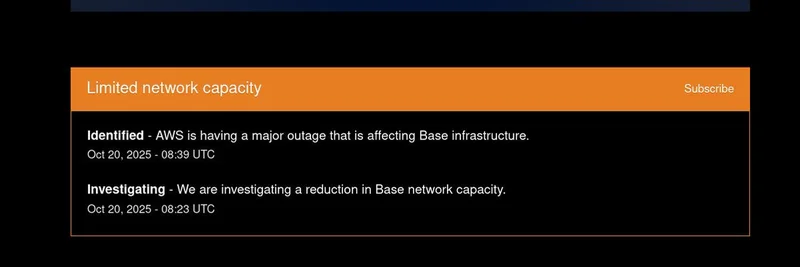If you're deep into the world of meme tokens on the Base chain, you might have hit a snag today. On October 20, 2025, the Base network—a go-to Ethereum Layer 2 (L2) solution for cheap and fast transactions—experienced a major hiccup. This was spotlighted in a pointed tweet by João Mendonça, better known as @joaomendoncaaaa on X, who poked fun at the network's centralized setup.
Breaking Down the Outage
The trouble kicked off around 8:23 UTC when the Base team started investigating a drop in network capacity. By 8:39 UTC, they pinned it down: a widespread AWS outage was hammering their infrastructure. AWS, or Amazon Web Services, is the cloud giant that powers a ton of web apps, including parts of Base's operations. When it goes down, it can ripple through the crypto space like a bad meme gone viral.
For those new to this, Base is built on the Optimism stack, an L2 that bundles transactions to make them cheaper and quicker than on Ethereum's mainnet (L1). But right now, with reduced capacity, transactions are slowing down or failing, which is a nightmare for anyone trying to trade volatile meme coins.
Impact on Meme Token Traders
Base has become a hotspot for meme tokens—think of all those degen plays and community-driven coins that thrive on low fees and high speed. Projects like various cat-themed or frog-inspired tokens often launch here because it's accessible for retail traders. But with this outage, you're looking at potential delays in swaps, failed mints, or even missed pumps.
If you're holding or trading meme tokens on Base, this could mean higher gas costs if you switch to L1, or just sitting tight until things normalize. It's a reminder that even L2s aren't immune to real-world tech glitches, especially when relying on centralized cloud services like AWS.
The Centralized Sequencer Spotlight
João's tweet nails a hot debate in the crypto community: "BuT tHE ceNTrAlIZeD SeqUEnCeR cAn HavE ReDUnDAncy." Sarcasm aside, what's a sequencer? In simple terms, it's the component that orders and batches your transactions before posting them to Ethereum. Base currently uses a single, centralized sequencer run by the team, which promises efficiency but comes with single points of failure—like this AWS dependency.
The tweet urges folks to "go submit your txns through the L1," which is Ethereum's main chain. Sure, it works as a fallback, but it's pricier and slower, defeating the purpose of using an L2. Base has plans to decentralize the sequencer eventually, which could add more redundancy and resilience. Until then, events like this fuel calls for faster decentralization in the blockchain space.
What Should You Do Next?
Don't panic—outages happen, even in crypto. Here's some quick advice:
Monitor the Situation: Keep an eye on the official Base Status page for real-time updates. As of now, the issue is identified, but resolution timelines aren't out yet.
Fallback to L1: If you need to make urgent transactions, route them directly through Ethereum. Tools like MetaMask or other wallets can help switch networks.
Diversify Chains: Consider spreading your meme token plays across other L2s like Arbitrum or Optimism, which might not be affected.
Stay Informed: Follow key voices on X, like João Mendonça, for unfiltered takes on these events.
This outage underscores the growing pains of blockchain tech as it scales. For meme token enthusiasts, it's a bump in the road, but also a chance to learn about network reliability.
At Meme Insider, we're all about keeping you ahead in the wild world of meme coins. Check back for more updates on this and other crypto happenings. If you've got tips or stories from the trenches, hit us up!


